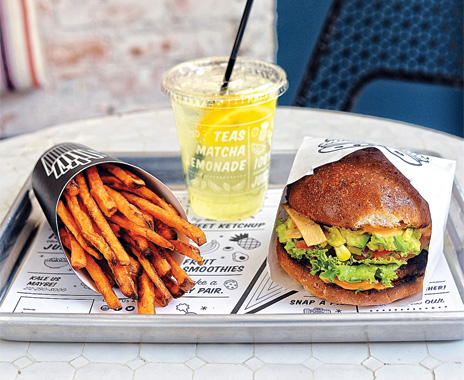Obesity is on the rise, with two-thirds of American adults considered overweight or obese. Millions lack consistent access to affordable, healthy food. And as the world stares down the prospect of feeding 9 billion people by 2050, studies indicate that developed-world levels of meat consumption are unsustainable for our growing global population.
Meanwhile, for a growing number of consumers, health is no longer measured simply in calories, fat grams, or milligrams of sodium. Instead, they’re turning to nourishing food—the kind of healthful mindset that tells a story, the kind that’s made with high-quality, traceable ingredients.
In this environment of evolving consumer expectations and increased dietary and planetary woes, many legacy quick serves are struggling to stay viable, suggesting that an industry built on feeding the mainstream quickly, conveniently, and affordably can no longer afford to ignore the importance of health and nutrition. And others, especially growing fast-casual brands, are evolving the model of freshly prepared, customizable meals, proving that health and nutrition can indeed factor into the limited-service mission.
For the first time since the Commerce Department started collecting data in 1992, Americans are spending more on dining out than groceries. The shift is driven largely by Millennials, who are set to overtake baby boomers as the largest generation.
Not only do they eat out more than their parents—most often at fast-casual restaurants—but they also define “health” differently. Unlike previous calorie-counting generations, Millennials deem healthy food as fresh, less processed, and containing fewer artificial ingredients, according to a report by Morgan Stanley.
“We are definitely seeing a health movement, not a fad,” says Bonnie Riggs, restaurant industry analyst at research firm The NPD Group. “Consumers report healthy as the No. 1 characteristic they want to see more of on restaurant menus, and what they mean by that is they’re looking for food that’s real.”
Because naturalness is increasingly aligned with health, consumers are embracing positive cues that suggest inherent goodness, like whole grain, fiber, and even the “good” fat naturally found in foods like avocados and coconut oil, Riggs says.
Research at fellow data provider Mintel supports this sentiment. The company’s 2016 food trend report shows that fat is no longer considered a barrier in the search for healthy food.
“Consumers have become more open-minded about fat,” says Jenny Zegler, global food and drink analyst at Mintel. “This presents more opportunity for operators to offer consumers that range of options, so they can pick and choose when they want healthy fats in their salads or indulgence with a great dessert.”
Picking and choosing is key in embodying a more balanced approach to health. At Philadelphia-based Honeygrow, consumers use touchscreen kiosks to customize stir fries and salads knowing that all ingredients are responsibly sourced and, when possible, local and organic, says chief brand officer Jen Denis.
“Our food is as healthy as you want to make it, but it’s all wholesome ingredients, and we stand behind our sources,” Denis says. “If you want to put bacon on your salad, that’s up to you. But if you do, you’ll know that bacon came from Creekstone Farms all-natural pork.”
One target that’s surfaced as the new health movement takes shape is artificial ingredients. LYFE Kitchen made “minimally processed” part of its identity. Established chains from Panera and Noodles & Co. to Yum! have also made commitments to phase out artificial ingredients and preservatives from menus, bowing to consumer demand.
Anti-artificial sentiment could also explain why consumers remain wary of genetically modified organisms (GMOs) despite little scientific evidence to suggest they are unhealthy. Some 57 percent say they’re concerned about GMOs compared with 46 percent 10 years ago, Riggs says.
From vegan to carnivore and everything in between, consumers are increasingly enamored with protein; 26 percent say they’ve upped their intake over the past two years, according to Innova Market Insights. More recently, mainstream consumers are embracing alternative protein sources, Mintel finds.
And while research from The NPD Group does not show an increase in the number of people who identify as vegetarian or vegan, more people are interested in incorporating meatless meals into their weekly routines, both for the health and environmental benefits.
“Vegetables have become another tool in the center-plate toolkit,” Zegler says. “Yes, you do have people consciously doing Meatless Monday, but we’re seeing more people not even noticing that they didn’t have meat that day, because falafel just sounded good.”
It took Chloe Coscarelli, chef and owner of vegan fast casual by CHLOE, two years to perfect her veggie burger recipe, which, like everything on her menu, had to pass the “carnivore taste test.”
“It’s surprising to us in how many of our customers are not at all interested in becoming vegan or even vegetarian,” she says. “It’s just a way people want to eat because of the way they feel afterward.”
While the brand does educate consumers about the benefits of a plant-heavy diet, Coscarelli says she’s more focused on flavor.
“We don’t want to feel like you’re in a science lesson; we want you to enjoy the meal,” she says. “My philosophy is that changing the world through food and good-tasting ingredients is the best way.”










